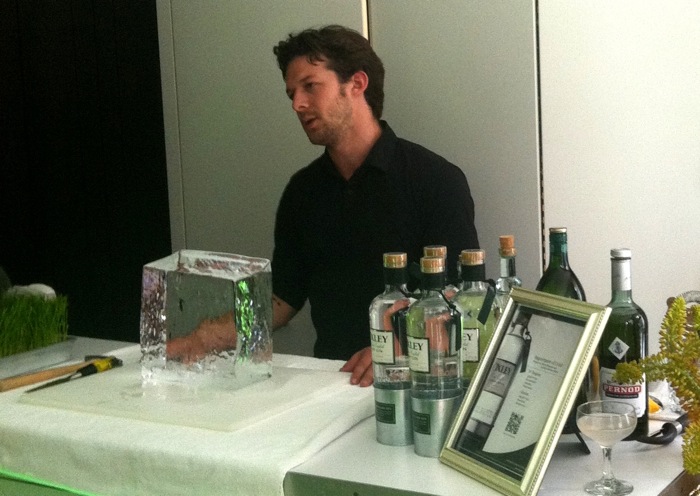
This week is Cocktail Week on Cooking District, a time to focus on what exactly goes into making a great cocktail. Quality spirits and excellent mixers are key, and we will be talking about them later in the week, but first up we want to take a look at an often unsung element in a great drink — the not so humble ice cube.
The first ice age, at least the beverage related one, was launched by a man named Frederic Tudor, aka Boston's "Ice King", who had the genius idea to bring cold beverages to the masses. He founded the Tudor Ice Company in the early 1800s harvesting massive amounts of ice from frozen ponds in New England and distributing the icy gems by ship to steamy climes — the Caribbean, Southern Europe and India.
We have come to take the availability of ice for granted over the ensuing centuries, but it has the capacity to make or break a well-crafted cocktail. Most standard cubed or crushed ice available on the market today is made with unfiltered tap water, which may contain impurities and minerals that can cloud the taste of a spirit or cocktail. This type of ice may also dilute a high quality beverage quickly due to the high volume of surface area exposed to the drink.
Just like the right glassware, the right type of ice can elevate a cocktail and using the wrong size or shape of ice cube can dilute a drink. A general rule is the stronger the beverage, the bigger the cube, i.e. 1 large cube for an Old Fashioned or Bourbon on the rocks. Playful juleps or tiki-style cocktails require ice to chill a drink quickly as well as to water it down a bit, which is why crushed ice is ideal for these types of drinks. Most martinis only need only a whisper of ice (shaken or stirred) — too much can lead to dilution and ruin the spirit's aromatics and the cocktail's smooth texture, which is why it is also key to use quality produced ice to limit any impurities.
Sound confusing? Fortunately there is a new generation of Ice kings — and queens — on the rise.
One company in particular, who has mastered the skill of hand-carved cocktail ice, is Hundredweight in New York City. Founded by Bartender and Owner, Richard Boccato of Dutch Kills Bar and Pain Killer and barman Zachary Gelnaw-Rubin, Hundredweight supplies artisanal ice to several bars throughout the five boroughs. They found a very cool, no pun intended, niche for themselves in the industry and are now known as the ice authorities and ice historians within the bartending community.
I was lucky enough to sit down with the ice-man Zack Gelnaw-Rubin to learn about the importance of the frozen water they are making and hear how their operation runs:

Q: What makes the ice you craft unique?
A: We hand chisel 300 lb blocks of clean ice every 3.5 days, then hand-pack and hand-deliver, it’s a very “hands” on operation. We carve several styles of ice, including 4 sizes of rocks (i.e. Cubes) ranging in sizes from 1.75” to 3”, Highball spheres, Crushed Ice, and large format Punch Ice Bowls.
Q: How do you make 300 lb blocks of ice, and where?
A: We use Clinebell Ice Machines and freezers at Dutch Kills and Weather Up Tribeca. These machines produce the amount of ice we need and have created a system of production that is efficient enough to sell and distribute our ice daily to customers in the New York area.
Q: How did you learn the craft of making bar ice?
A: I began my ice studies as a bartender at Dutch Kills. During my training there I learned how to create rocks and shaking ice using only a hand-saw, mallet and chisel. When Richie asked me to be his right hand in the opening of Weather Up TriBeCa, I was introduced to the Clinebell machine, and the first stirrings of making “ice” a viable business venture. I asked Richie if he would want to partner with me and Hundredweight was born.
Q: What is your favorite style or shape of ice to make?
A: I don't really have a favorite style to make. It's all frozen water to me.
Q: On average, what is the melting time for the 2 inch cubes before it starts to dilute a spirit? How is that compared to average bar ice?
A: The moment any ice touches a liquid, it begins a phase change. However, in a barroom setting, one large cube will forestall the inevitable over-dilution of any spirit or cocktail for much longer than say, a handful of Kold Draft ice cubes. It's a matter of reduced surface area; one large cube has less surface melt in contact with the liquid being chilled than a bunch of small ones. In addition, "big ice" is meant to be stored in a freezer during service, as opposed to scoop ice, which sits in a room-temperature bin all night long. This factor also contributes greatly to increased control over temperature and water content.
Q: Do you ever offer ice classes to the public?
A: We don't offer classes to the general public, but we do offer free trainings to new bar clients who want their staff to become proficient in the ways of ice cutting.
Q: Strangest ice request to date?
A: We've gotten some pretty strange requests, as many people think we are sculptors and want horses and penguins and scale models of the Statue of Liberty and such, but the strangest that I've actually executed would be a tie between a giant vodka luge for Hugue DuFour of M. Wells and an order of 20 ice scorpion bowls for an event at Pain Killer.
Q: Any last words of wisdom?
A: Better ice makes better cocktails!